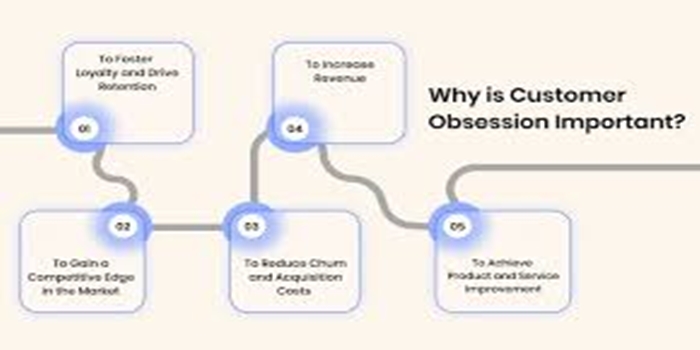In this article, we explained the meaning of designing for obsessions in business, the principles, how to implement it, the examples and the benefits.
Definition
Designing for Obsession in business, especially regarding customer obsession, means prioritizing and focusing on customer needs and satisfaction above all else. It involves creating a culture where understanding and meeting customer needs is the driving force behind all decisions and actions. This involves deeply understanding customer problems and pain points, actively seeking feedback, and consistently striving to improve the customer experience.
Principles of Customer Obsession:
Empathy and Understanding:
A customer-obsessed business goes beyond simply meeting customer needs; it strives to understand the customer’s entire perspective, including their motivations, goals, and potential pain points.
Continuous Feedback Loops:
Customer-obsessed businesses actively seek feedback from customers and use that feedback to improve their products, services, and overall experience.
Focus on Customer Value:
The goal is to create products and services that deliver significant value to customers, exceeding their expectations and building long-term loyalty.
Internal Alignment:
Customer obsession is not just a marketing tactic; it requires a genuine commitment from all employees to prioritize the customer’s needs.
Data-Driven Decisions:
Customer-obsessed businesses use data to track customer behavior, measure satisfaction, and make informed decisions about product development and marketing.
How to Implement Customer Obsession:
Document Every Customer Touchpoint:
Identify all the ways customers interact with your business and analyze these touchpoints to identify areas for improvement.
Empower Frontline Teams:
Give frontline employees the authority to make decisions that directly impact customer satisfaction, such as resolving issues or addressing concerns.
Create Real-Time Feedback Loops:
Establish systems for collecting and sharing customer feedback in real-time, allowing for quick adjustments and improvements.
Prioritize Customer Requests:
Pay close attention to customer requests and use them as a basis for developing new products and services.
Build Customer Insights into Product Development:
Incorporate customer insights into the product development process to ensure that new features and products meet customer needs and expectations.
Foster a Culture of Curiosity:
Encourage employees to ask questions, explore new ideas, and continuously seek ways to improve the customer experience.
Celebrate Customer Success:
Acknowledge and celebrate customers who have been satisfied and loyal, and use these success stories to motivate other employees.
Engage with Customers on Social Media:
Use social media to interact with customers, listen to their feedback, and build relationships.
Focus on Quality:
Ensure that your products and services are of high quality and provide a positive customer experience.
Ensure Internal Alignment:
Ensure that all employees are aligned with the customer-obsessed mindset and are committed to delivering a positive customer experience.
Be Honest and Transparent:
Maintain honesty and transparency in all interactions with customers.
Here are Some Examples Designing for Obsession in business:
Customer-Centric Design:
Companies like Disney and Amazon are known for their “customer obsession”. This means they relentlessly focus on understanding and anticipating customer needs, exceeding expectations, and creating a positive experience at every touchpoint.
Product Design Obsession:
A product designer might obsess over the user interface, making sure every button, every icon, and every interaction feels intuitive and pleasurable. This could involve meticulous attention to detail, like perfecting the kerning of text or ensuring perfectly straight Bezier curves.
Experience Design Obsession:
In areas like web design or app development, designers might obsess over creating a seamless and engaging user experience, making sure that the website or app feels like an extension of the user’s mind.
Obsession with Quality and Craft:
Some designers might obsess over the quality of materials, the precision of craftsmanship, or the aesthetics of a product, ensuring it is a true work of art.
Obsession with Usability:
A usability-focused designer might spend hours testing a product, identifying and resolving usability issues, and making sure it is easy and enjoyable for everyone to use.
The Benefits of Designing for Obsession in Business:
- Superior Customer Experience:
Enhanced Customer Satisfaction:
By deeply understanding and addressing customer needs, designers can create products and experiences that are more satisfying and relevant to their target audience.
Increased Loyalty and Advocacy:
When customers feel genuinely understood and valued, they are more likely to become loyal advocates for the brand, recommending it to others.
Improved Retention:
A focus on customer satisfaction leads to a higher likelihood of customers returning for future purchases, building a stronger customer base.
- Innovation and Quality:
Detailed Attention:
Obsession with design details, whether it’s pixel perfection or user flow, can elevate a product or service from good to exceptional, creating a more polished and engaging experience.
Problem-Solving:
A relentless focus on solving customer problems can drive innovation, leading to new products, services, or features that address unmet needs.
Greater Creativity:
Hyper-focus on a specific area can foster a deep level of creativity, allowing designers to explore unconventional ideas and solutions.
- Business Growth and Success:
Increased Revenue:
By attracting and retaining customers, and driving sales through exceptional experiences, a customer-obsessed approach can lead to higher revenue and profitability.
Stronger Brand Reputation:
A consistent focus on customer satisfaction and quality can build a strong brand reputation, enhancing its overall appeal and value.
Employee Engagement:
When employees are empowered to focus on customer needs and create exceptional experiences, it can lead to higher employee engagement and satisfaction.
- Personal Growth:
Development of Expertise:
Obsession with a particular area can lead to the development of deep expertise and a heightened sense of mastery in that field.
Creative Outlet:
For creative individuals, obsession can be a powerful way to express their inner thoughts and feelings, allowing them to create meaningful and impactful work.
Increased Motivation:
A strong obsession can fuel a relentless drive to achieve a specific goal or create something exceptional.
Conclusion
Designing for obsession refers to designing with the goal of creating products or experiences that users are highly engaged with and find compelling, even to the point of becoming obsessed. This approach focuses on capturing and reinforcing users’ interests, desires, and behaviors to build a strong emotional connection and encourage continued use.


